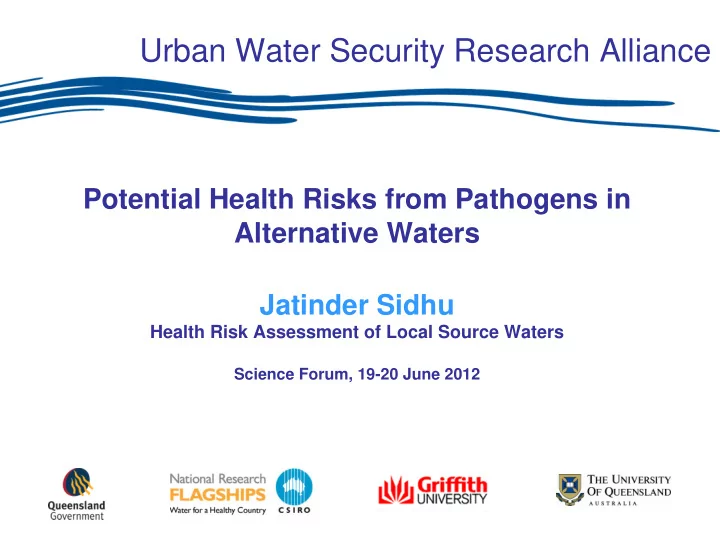

Urban Water Security Research Alliance Potential Health Risks from Pathogens in Alternative Waters Jatinder Sidhu Health Risk Assessment of Local Source Waters Science Forum, 19-20 June 2012
Captured Stormwater • Alternative water source which can be used to augment non-potable and potable supplies around cities • Involves collection of runoff from creeks and drains • Potential health risks from pathogens • Understanding of loadings and sources of pathogens required for improved health risk assessment
Aims of the study • to determine the prevalence of pathogens • to check association between MST and chemical markers of sewage pollution • to determine if adenovirus numbers vary during the storm event
Sampling Sites
Makerston Street site
Site Description Potential source of faecal pollution Site name Land Use Fitzgibbon drain, Residential Sewage pipe network, small numbers of horses Brisbane and cattle Hornsby, Sydney Urban Sewage pipe network roads/carpark Banyan Creek, Residential Sewage pipe network, Melbourne Smith Street, Commercial Sewage pipe network, industry Melbourne Makerston Street, City, commercial Sewage pipe network Brisbane
Fitzgibbon drain Autosamplers Makerston street
Stormwater Sampling • 20-40L samples collected from 5 sites in Melbourne, Brisbane and Sydney • Five mL concentrated sample used for detection of MST markers and pathogens • One L sample used for the capture of Adenovirus
Methodology • Pathogens – Hemoflow HF80S filters – PCR detection • Faecal indicators – Membrane filtration
Microorganisms • Viral Pathogens – Adenovirus • Bacterial Pathogens – Campylobacter jejuni • MST markers – Bacteroides HF183 – Metahonobrevibacter smithii nifH
Chemical Markers • Food – Caffeine – Acesulfame • Pharmaceuticals – Paracetamol – Aspirin
FIB Results • E. coli numbers as 40 to 6560 cfu 100mL -1 • Enterococcus spp. numbers 1930 to 22600 cfu 100mL -1 • Enterococcus spp. numbers tenfold or more higher than E. coli across all sites
Sites FIB* Pathogens MST Food markers Pharmaceuticals markers HF183 nifH Acesulfame Caffeine Paracetamol Aspirin E. coli Enterococ Adeno C. jejuni cus virus Fitzgibbon 8/12/2011 3600 16700 + - + + + + - + 3560 11800 + + + + + + + 17/04/2012 Hornsby 40 1930 + - + - + + + + 15/02/2012 100 20900 + + + - + + + + 20/02/2012 Banyan 3400 10200 + - + - + + + - Creek 9/11/2011 7200 22600 + + + - + + + + 6/02/2012 - Smith Street 6560 152000 + + + + + - + - 30/09/2011 - 7900 + - + + - - - - 28/02/2012
Biological and Chemical markers • Eight samples tested from four sites • All samples (100%) positive for Adenovirus and HF183 • Five samples (63%) positive for five markers, two positive (25%) for four markers • Chemical and MST markers confirm presence of sewage contamination
Adenovirus Results 0.50 500 1.5 10000 0.45 1.4 400 8000 0.40 Adenovirus number L -1 1.3 Adenovirus number L -1 0.35 Water Depth 300 Water Depth 1.2 6000 0.30 1.1 0.25 200 4000 1.0 0.20 100 0.9 2000 0.15 0.8 0.10 0 0 1 2 3 4 5 1 2 3 4 5 6 Sam ple Num ber Sam ple Num ber Makerston St Fitzgibbon St
Adenovirus • Both sites tested positive for Adenovirus • Makerston Street numbers 148 to 400 pdu L -1 • All samples positive during the storm event • Fitzgibbon drain numbers 0 to 9000 pdu L -1 • From Fitzgibbon drain data, higher numbers appear to coincide with peak of event • Potentially other enteric virus also present
Conclusions • Enterococcus spp. numbers several fold higher than category D (<501 Enterococci per 100mL -1 ) under Australian guidelines for managing risks in recreational water (NHMRC 2008). • Adenovirus present in samples from all sites. • C. jejuni detected in 50% of samples from 4 sites tested. • Wide prevalence of MST and chemical markers suggest sewage contamination of stormwater. • Some degree of captured stormwater treatment is required prior to non-potable use.
Acknowledgements Co-authors: R. Aryal, A. Palmer, W. Ahmed and S. Toze • Urban Water Security Research Alliance, a scientific collaboration between the Queensland government, CSIRO, The University of Queensland and Griffith University • Monash University’s Cities as Water Supply Catchments program funded by the National Water Commission, the Victoria Smart Water Fund and a broad range of governmental and industry partners as listed on the program’s website (http://www.watersensitivecities.org.au/programs/cities-as-water- supply-catchments/)
Urban Water Security Research Alliance THANK YOU! www.urbanwateralliance.org.au
Recommend
More recommend